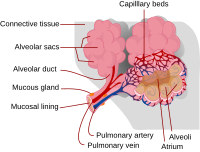
Photo from wikipedia
Severe acute respiratory syndrome coronavirus 2 (SARS‐CoV‐2) has continued evolving for survival and adaptation by mutating itself into different variants of concern, including omicron. Several studies and clinical trials found… Click to show full abstract
Severe acute respiratory syndrome coronavirus 2 (SARS‐CoV‐2) has continued evolving for survival and adaptation by mutating itself into different variants of concern, including omicron. Several studies and clinical trials found fluvoxamine, an Food and Drug Administration‐approved antidepressant drug, to be effective at preventing mild coronavirus disease 2019 (COVID‐19) from progressing to severe diseases. However, the mechanism of fluvoxamine's direct antiviral action against COVID‐19 is still unknown. Fluvoxamine was docked with 11 SARS‐CoV‐2 targets and subjected to stability, conformational changes, and binding free energy analyses to explore its mode of action. Of the targets, nonstructural protein 14 (NSP14), main protease (Mpro), and papain‐like protease (PLpro) had the best docking scores with fluvoxamine. Consistent with the docking results, it was confirmed by molecular dynamics simulations that the NSP14 N7‐MTase ((N7‐guanine)‐methyltransferase)–fluvoxamine, Mpro–fluvoxamine, and PLpro–fluvoxamine complexes are stable, with the lowest binding free energies of −105.1, −82.7, and − 38.5 kJ/mol, respectively. A number of hotspot residues involved in the interaction were also identified. These include Glu166, Asp187, His41, and Cys145 in Mpro, Gly163 and Arg166 in PLpro, and Glu302, Gly333, and Phe426 in NSP14, which could aid in the development of better antivirals against SARS‐CoV‐2.
Journal Title: Cell Biochemistry and Function
Year Published: 2022
Link to full text (if available)
Share on Social Media: Sign Up to like & get
recommendations!